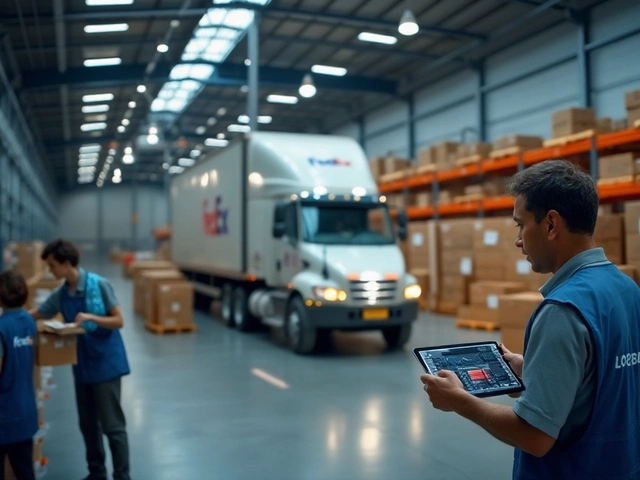The thought of hitting the open road as a courier can be tempting, with the promise of daily adventures and meeting new faces. But if you're wondering whether it pays the bills, there's a bit more to uncover. Couriers face a unique set of challenges and opportunities, intertwined in the complexity of this modern workforce role. Let's dive into the ins and outs of reaping financial rewards at the wheel, and find out just what makes couriering a viable—or not so viable—way to earn a living.
From understanding the baseline duties to breaking down costs, we'll explore how couriers can maximize their income. We'll examine the intricacies of cash flow, the ebb, and flow of market demands, and the tips needed to keep your head not just above water, but well within reach of those sunny shorelines where profit swims freely.
- Understanding the Courier Role
- Analyzing Costs and Overheads
- Maximizing Income Potential
- Navigating Market Trends
- Practical Tips for Aspiring Couriers
Understanding the Courier Role
Being a courier in today's bustling service economy is more than just getting behind the wheel and driving from point A to point B. This job requires a comprehensive understanding of logistics, time management, and customer service. A courier acts as the lifeline between businesses and their customers, ensuring that goods and messages are delivered with precision and care. It's a job best suited for those who thrive in dynamic environments, where no two days are the same. Efficiently planning routes and managing time are just the tip of the iceberg; couriers must also navigate traffic laws, weather conditions, and unexpected delays, all while maintaining a professional demeanor.
An intriguing aspect of the courier services industry is its variety. Couriers might deliver everything from documents and parcels to oversized packages and delicate goods that require extra care. This diversity of tasks underscores why adaptability and problem-solving skills are crucial. A pivotal part of the courier’s task is managing client relationships, often becoming the face of the companies they represent. Regular interactions with clients mean that excellent communication skills and a customer-first attitude can set a courier apart from their competitors, leading to more business opportunities and possibly higher rates.
According to a study conducted by the Bureau of Labor Statistics, the demand for couriers and messengers is expected to grow by 4% from 2021 to 2031. This steady growth reflects the increasing reliance on delivery services, particularly with the surge in e-commerce. Indeed, many companies have outsourced their delivery needs to third-party courier services, creating a myriad of job opportunities. Interestingly, a courier can choose to work for a corporation with consistent hours, or as an independent driver with the flexibility to set their schedule. Each pathway offers its own set of pros and cons that could influence earnings and lifestyle choices.
"Becoming a successful courier hinges on more than just speed and efficiency. It's about reliability, trust, and building relationships," says James Collins, veteran courier and industry analyst. "The most successful couriers are those who anticipate needs and deliver exceptional service consistently."For those planning to delve into the courier business, embracing technology is key. Modern couriers use advanced GPS systems, route optimization tools, and customer service platforms to enhance their service delivery. These tools not only help in saving time and fuel but also improve the customer experience by providing real-time tracking and notifications.
One can't discuss the realities of courier work without mentioning the physical demands. The day-to-day tasks require a decent level of physical fitness, as couriers are often lifting and carrying various package sizes. It’s not unusual for couriers to start their day with a scheduled pickup and end it with deliveries stretching across vast territories, some even across states. While this might seem daunting, many couriers find the active lifestyle and outdoor elements as attractive features of the job, contrasting the humdrum of desk jobs.
Analyzing Costs and Overheads
Embarking on a journey into the world of courier services certainly provides a sense of freedom and flexibility, yet understanding the hidden costs is crucial for determining if this career path can be financially rewarding. At the heart of courier life lies the constant engagement with fundamental expenses. For starters, vehicle maintenance slices a hefty portion of a courier's income. It's not merely oil changes and tire rotations; there's brake replacement, regularly scheduled tune-ups, and unplanned repairs that can sneak up like sudden rainfall on a sunny day. A delivery driver must ensure their wheels are in peak condition, especially those who clock ambitious miles each week.
Beyond the garage fees, fuel expenditure is a vital player in this narrative. Couriers traverse cities and suburbs alike, resulting in fluctuating gas prices becoming a daily concern. While larger cities may ease some of this burden with mass transit options or eco-friendly deliveries, the reality for many includes watching fuel gauges drop too precipitously. It begs the question of whether a shift to electric vehicles can make a meaningful financial impact, despite their higher upfront costs. According to the U.S. Energy Information Administration, fuel typically accounts for about 20% of a courier's monthly operating costs.
The cost story doesn't end at the gas pump or repair shop. Insurance is another leg in this financial triathlon. Couriers must navigate the labyrinth of insurance policies that reflect the unique risks of their business. Commercial insurance offers significant protection, yet it can be noticeably more costly than personal plans. Having the right coverage is non-negotiable, with premiums varying based on location, vehicle type, and driving history. Additionally, some companies provide liability insurance, but not all drivers are so fortunate. Understanding the myriad subsets of insurance policies reveals a hidden layer of consideration for any aspiring courier.
"The profitability of a courier service hinges on actively managing operating costs," states logistics expert John Lowe from Couriers International. "Knowing where each penny goes is half the battle in rising above typical margins."
Next, dive into technological expenses. While a smartphone might seem like second nature, the apps that enable a courier to navigate and track their deliveries often come with subscription fees. Routing software, fuel finders, and vehicle maintenance trackers are tools of the trade, nudging another line item into the budget. As technology advances, these tools become indispensable, leading to better efficiency but also higher recurring costs.
Finally, let’s not forget other miscellaneous costs, from parking fees and tolls to couriers bearing witness to meet unexpected equipment needs such as insulated bags or sturdy crates. Also, with business inevitably comes taxation - comprehending the specific city or state tax implications related to operating as a courier is key. Beyond these personal expenses and taxes, companies may have additional contracts, such as commission rates that can either bolster or compromise a courier's final take-home pay.

Maximizing Income Potential
For those considering a career in courier services, it's essential to explore ways to maximize your earnings while cutting down unnecessary costs. The journey begins with choosing the right mode of transport that aligns with your delivery area and volume. Many couriers find success using fuel-efficient vehicles or opting for bikes in denser urban settings, where maneuverability can save time and gas money. In fact, utilizing a mix of transport options based on the type of delivery can significantly impact the bottom line by adapting to the needs of each specific job.
Besides transport considerations, structuring your day effectively can also lead to higher income. The clock is not just a timeline; it's a golden resource. Scheduling deliveries during off-peak hours can reduce time wasted in traffic, allowing you to handle more deliveries and increase earnings. Planning routes meticulously, perhaps aided by delivery apps or GPS technology, minimizes unnecessary detours, optimizing every mile driven or pedaled. It's about making every moment and movement count, transforming time spent on the job into tangible rewards.
Another key strategy is to leverage technology. Signing up with multiple delivery apps broadens your customer base and can lead to a steady influx of jobs. According to gig economy experts, "Diversifying your platforms not only increases opportunities for work but also provides a safety net if one app's demand fluctuates." This way, you're not putting all your eggs in one basket and can swiftly adapt to market changes without facing a sudden dip in income.
Building relationships with clients is also a critical pathway to boosting profitability. Couriers who regularly deliver to specific areas can establish trust with local businesses or frequent customers, leading to potential direct contract opportunities, repeat business, and even tips. Providing excellent service that stands out can set you apart in a bustling market, where personal touch is often the differentiator. Remember, a friendly smile or going the extra mile can convert a one-time job into a recurring gig.
Courier business trends can provide keen insights into what's next. Staying informed about shifts in e-commerce or local delivery needs can help you position yourself strategically. Whether it's the increase in grocery deliveries or an uptick in sustainable delivery services, keeping a finger on the pulse of these trends can guide you to expand your skill set or transportation options to match evolving demands.
Finally, managing the bookkeeping wisely can prevent financial leaks. Regularly tracking expenses like maintenance and fuel ensures you're not blindsided by sudden costs. Some experienced couriers suggest using dedicated expense tracking software or apps, making it easy to visualize where the money goes each month and redirecting resources where they'll yield the best return on investment. Such insights can ultimately transform your courier endeavors into a thriving and profitable career.
Navigating Market Trends
In the evolving world of courier services, staying ahead of market trends is crucial for success. The demand for couriers has been fluctuated over years, spurred by the rise of e-commerce giants and driven by consumers’ expectations for faster delivery times. For couriers, this environment offers both challenges and opportunities to adapt and thrive. With the gig economy offering flexibility, many individuals have chosen to become their own bosses, creating competition but also diversifying the service offerings available to customers. Staying informed about these trends involves keeping a close eye on shifts in consumer behavior and technological advancements that impact delivery logistics.
The ecommerce boom, for instance, continues to transform the delivery landscape. Retail purchases are increasingly moving online, with projections indicating that global e-commerce sales could reach as high as $6.4 trillion by the end of 2024. For couriers, this translates to more packages to deliver, but also increased pressure to meet tight delivery windows. Adapting means investing in efficient logistics technology, which can streamline routes and reduce fuel costs. Couriers who embrace technology are better poised to handle the demands of a modern delivery business, offering speed and reliability to their clients.
Another trend impacting courier work is sustainability, as consumers become more conscious of their carbon footprint. Green logistics has emerged as a key area of focus, with companies seeking eco-friendlier delivery options. Incorporating electric or hybrid vehicles into the fleet can significantly cut emissions and appeal to clients who value environmental responsibility.
"Electric vehicles are propelling the freight industry towards a greener future," remarks an industry analyst in The Courier Times. "They offer a competitive edge to those willing to invest."Couriers who align with this trend could find themselves opening doors to new business opportunities, particularly with companies focused on sustainability.
The advent of autonomous delivery technologies is also rewriting the rulebook for how traditional couriers operate. While drones and driverless vehicles might still seem like something out of science fiction, they are steadily becoming part of the logistics scenery. With tech giants pouring resources into these innovations, it won't be long before autonomous solutions are feasible options for everyday deliveries. This doesn't make traditional couriers obsolete; rather, it encourages them to explore hybrid delivery models where manual and automated methods work hand-in-hand, optimizing efficiency and customer satisfaction.
Against this backdrop, understanding these market trends and how they shape the courier landscape can be a game-changer. Keeping a finger on the pulse of technological advances, consumer demands, and eco-conscious initiatives can ensure that couriers remain competitive. Constant evolution is the name of the game, and those who stay informed and strategic are more likely to see sustained profitability in this fast-paced industry.

Practical Tips for Aspiring Couriers
Diving into the world of courier services can be as thrilling as it is rewarding. You're the captain of your time, your ride your trusty steed, and out there lies a maze of streets waiting to be conquered. Yet, there is more to this than simply grabbing a package and taking it from point A to B. To truly thrive in this industry, a sprinkle of diligence and a dash of savvy are required. Knowing your local area like the back of your hand is just the tip of the iceberg. It's also critical to hone your communication skills, build customer rapport, and keep an eagle's eye on expenses.
To kickstart your venture and stay a step ahead, consider experimenting with various courier platforms. Each has its pros and cons, with differences in pay rates, demand cycles, and support structures. It’s worth bearing in mind that during peak times, some platforms might offer incentives that boost your earnings. Speaking of which, fuel efficiency should be your mantra. Opting for routes with less traffic not only saves precious time but also trims down those fuel bills. In cities, stick to streets that favor your pace, whether cycling daintily through alleys or cruising speedily on busier roads.
Investing in Right Gear
Think of your equipment as a teammate. A reliable vehicle is imperative, yes, but so is smart tech. Resting in the palm of your hand, a smartphone filled with the best navigation app can transform your workday. Ever glanced at reviews of certain GPS apps? They wax lyrical about real-time updates navigating you around closed roads and guiding you through alternative routes when a traffic snarl looms. And the right smartphone mount keeps your safety in check—prize any second that prevents you from pulling over unnecessarily to fiddle with your phone.
While we’re on the subject of technology, tracking your earnings and expenses through robust apps can give you a bird’s-eye view of your business. Tools exist to offer budgeting advice too, framing the line between financial gain and excessive outlays. How else will you track just how profitable those runs are? Jotting down merchandise mileage, delivery tips, and maintenance fees along with your daily, weekly, and monthly incomes teases out the big picture.
"Preparation and planning are the keys to success in courier services," Elton Byers, a seasoned delivery veteran, remarked in a recent interview. "Anticipate what you can and be prepared to change gears when needed."
Building Relationships
The courier job is not only about timely deliveries but about the relationships crafted on the way. The smile you give and receive can be so rewarding. Return customers are often the bread and butter, so going the extra mile with impeccable service can ensure you're remembered fondly. Tailor communication style to fit; some clients adore chatter, while others favor quick exchanges over the threshold. Respect these preferences, and you’ll rack up positive reviews.
Lastly, dive into the world of networking. Join courier groups—online or offline. Here, you share stories from the road, get tips from fellow drivers, and sometimes even snag handy details about where demand peaks during specific seasons. What’s certain is that the busier the veins of the delivery world become, the better equipped you are hustling through the chaos, optimizing earnings, and crafting a courier career that suits your style.





